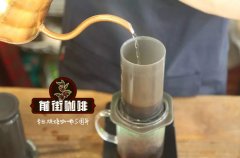Starbucks Ethiopia Kayon Kayong Mountain Coffee introduction Ethiopia Guji Coffee introduction

Professional coffee knowledge exchange more coffee bean information please follow the coffee workshop (Wechat official account cafe_style)
The translation of "kayon" means "goal". This is a beautiful mantra made by the farm owner to take care of and handle the coffee with all his heart and love. Workers on farms use large-scale pruning, and unlike the average coffee farmer, they use half of the land to plant shade trees, which is rare in Ethiopia. Most of the coffee trees here are wild. Kayong Mountain Farm has its own washing station, so it can directly export raw coffee beans and allow them to monitor every detail of coffee processing. You can taste the fragrance of beautiful flowers in the cup, and the beautiful coffee flavor presented in the cup fully proves the farm owner's dedication and determination to the coffee.
Kayong Mountain Farm is located in the Oromia area of the Guji producing area in southern Ethiopia, and "Kayon" means target.
In the past, Guji was listed as the producing area of Sidamo, but although the shape of Guji coffee beans is similar to Sidamo, it has its own unique style. After years of debate, the Ethiopian government has granted Guji producing areas a unique geographical distinction.
In 2015, Kayong Mountain Farm had its own washing station and dry sheller, so they could export coffee. Such coffee from a single farm is rare in Ethiopia.
The Kayong Mountain Farm covers an area of about 240 hectares and uses natural shade, covering more than half of the shade area. Animal manure is the main source of fertilizer.
The harvest season is from October to January of the following year, when Ato employs more than 300 farmers to help with the harvest and processing. Kayong Mountain has 25 long-term employees.
Ato pays more for his workers so that people are happy to work with him every year.
END
Important Notice :
前街咖啡 FrontStreet Coffee has moved to new addredd:
FrontStreet Coffee Address: 315,Donghua East Road,GuangZhou
Tel:020 38364473
- Prev

African COE competition country Luanda Musasha Coffee introduces what coffee varieties are grown in Rwanda
For more information on coffee beans, please follow Coffee Workshop (Wechat official account cafe_style) Rwanda Coffee, the most popular African coffee after Kenya and Ethiopia. But unlike the two famous producing countries, it does not have a long history of planting, let alone native varieties everywhere in the wild. This small African country is a fire Phoenix that has been reborn after robbery. Incense
- Next

Taste and Flavor characteristics of Coffee Bean varieties in Guatemala describe Historical Development Story Cooking parameters
Professional coffee knowledge exchange more information about coffee beans please follow the coffee workshop (Wechat official account cafe_style) Guatemala has been growing coffee since around 1850. Before World War I, the Germans controlled as much as 80% of the country's production, most of which was exported to Germany. In the 1990s, ANACAFE, the official coffee farmers' association, integrated the whole product according to its region and flavor.
Related
- Does Rose Summer choose Blue, Green or Red? Detailed explanation of Rose Summer Coffee plots and Classification in Panamanian Jade Manor
- What is the difference between the origin, producing area, processing plant, cooperative and manor of coffee beans?
- How fine does the espresso powder fit? how to grind the espresso?
- Sca coffee roasting degree color card coffee roasting degree 8 roasting color values what do you mean?
- The practice of lattes: how to make lattes at home
- Introduction to Indonesian Fine Coffee beans-- Java Coffee producing area of Indonesian Arabica Coffee
- How much will the flavor of light and medium roasted rose summer be expressed? What baking level is rose summer suitable for?
- Introduction to the characteristics of washing, sun-drying or wet-planing coffee commonly used in Mantenin, Indonesia
- Price characteristics of Arabica Coffee Bean Starbucks introduction to Manning Coffee Bean Taste producing area Variety Manor
- What is the authentic Yega flavor? What are the flavor characteristics of the really excellent Yejasuffi coffee beans?

